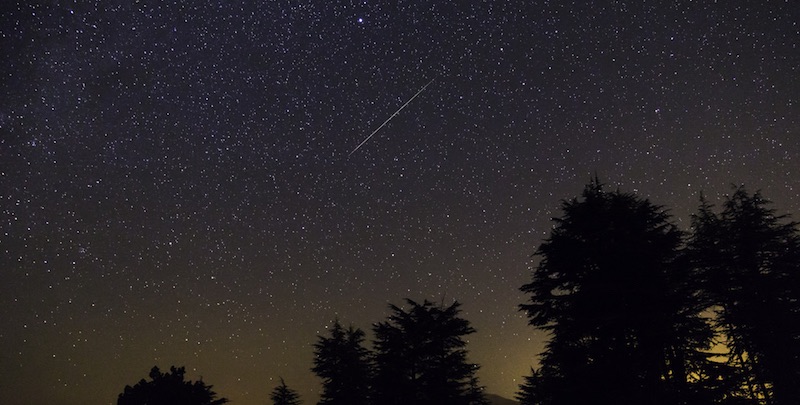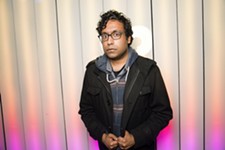Perseid Meteor Shower 101
We chat with the experts about when and where to see the night-sky show
By Ashley Moreno, 8:00AM, Tue. Aug. 9, 2016
Okay Perseid meteor shower, I’ll bite. But before anyone gets their hopes up, you need to understand: We’ve been burned before. Not once (supermoon, 2013), not twice (moon-sized Mars, 2013), but thrice (supermoon, 2015). We’re opening up here. Don’t screw us!
Periodically, the Internet turns its favorite block font away from its staple memes, and slaps it instead on astronomical promises of supermoons and other so-called rare observation opportunities. So when news of the Perseid meteor shower first crept into my feed, I was optimistic, but skeptical. Should I toss on my “the truth IS out there” T-shirt, grab a SURVIVE mix tape and an EpiPen, and then drive toward Manor in an effort to see an all-natural laser light show courtesy of Comet Swift-Tuttle? Or am I going to douse myself in bug spray for another quiet night of “meh”? To find out, I asked Dr. Judit Györgyey Ries, a research associate studying the physical characterization of near-Earth objects (especially Earth-crossing asteroids) at UT’s Department of Astronomy.
On any given night, you could see a meteor, or a streak of light caused by small objects or dust entering the atmosphere at high speeds. These are “sporadic meteors.” Sporadic meteors “are probably small pieces broken off of asteroids – asteroids between Mars and Jupiter,” says Ries. “The high-speed dust ionizes the atmosphere around it, emitting light while it burns up.” Very rarely, larger objects also enter the atmosphere producing fireballs, like the 2013 Chelyabinsk event over Russia. Sporadic meteors and fireballs are more or less singular events and appear from varying places in the sky. A shower is different. “A shower occurs at a specific time of year and generally includes lots of meteors all from the same direction,” says Ries. In the case of the Perseids, that direction is the constellation Perseus, which gives the shower its name. Other showers also follow this convention. For example, the Leonids shower radiant lies in the direction of the constellation Leo, for the Geminids it’s Gemini, and so on. “Perseid is probably the best known because it’s in the summer when you can be up, and it usually has fairly bright meteors in it,” she says. “Also, when the time is right, it’s one of the richest – so you can see quite a few.”
Unlike sporadic meteors, which often come from asteroid collisions, most showers come from “parent comets.” “For Perseid, it’s a comet called Swift-Tuttle,” says Ries. Showers occur when the Earth travels through the orbital path of the comet, which is littered with debris from previous trips around the sun. Here’s why: When the comet comes near the sun, it heats up quickly – sublimating its ice straight to gas. While this isn’t an explosive process (Ries describes it as “relatively smooth”), it does kick up a lot of dust. “When you release the dust, you put particles on slightly different orbits,” says Ries. “As time goes by, all these particles get almost evenly distributed along the orbit of the comet.” The result is a kind of tube of debris that occupies the comet’s elliptical orbit. “Whenever the Earth goes through, that’s when you get a meteor shower,” she says.
Some of the best years to watch a shower are those in which the parent comet happens to be close to the sun when the Earth goes through its debris trail. Ries says this is because the comet’s near-sun location produces new material for the Earth to travel through. While Swift-Tuttle isn’t in our neighborhood this year, the shower should produce some of the best viewing since 2009. Bill Cooke with NASA’s Meteoroid Environment Office in Huntsville, Ala., predicts an "outburst," upwards of 200 meteors per hour on the peak nights of Aug. 11-12. This outburst is caused by the pull of Jupiter and the other planets, which shift the Earth's orbit over the years. This year the Earth will go through the center of the debris tube, potentially providing twice as many visible meteors as other years. “Even if you just see one-third of the sky, you could easily see 60 to 70 meteors per hour,” says Ries, who also seems cautiously optimistic. “This is a prediction, and meteor showers are notoriously unpredictable,” she says. “But Perseid, especially when the moon is down, always puts on a nice show.”
If you want to watch the shower, go to the darkest place you can. (The city proper won’t really do.) Ries suggests Pedernales Falls State Park or Enchanted Rock, where she’s watched events in the past. Both parks offer overnight camping, which is nice as the best viewing will be after moonset at about 1am. Start looking at about 10pm. Don’t worry too much about the direction – just look up! For more information about the Perseid shower and other showers to watch this year, go to EarthSky’s 2016 meteor shower guide.
A note to readers: Bold and uncensored, The Austin Chronicle has been Austin’s independent news source for over 40 years, expressing the community’s political and environmental concerns and supporting its active cultural scene. Now more than ever, we need your support to continue supplying Austin with independent, free press. If real news is important to you, please consider making a donation of $5, $10 or whatever you can afford, to help keep our journalism on stands.
April 30, 2019
April 29, 2019
Perseid meteor shower, Perseids, Judit Györgyey Ries, meteors, comets, Swift-Tuttle










